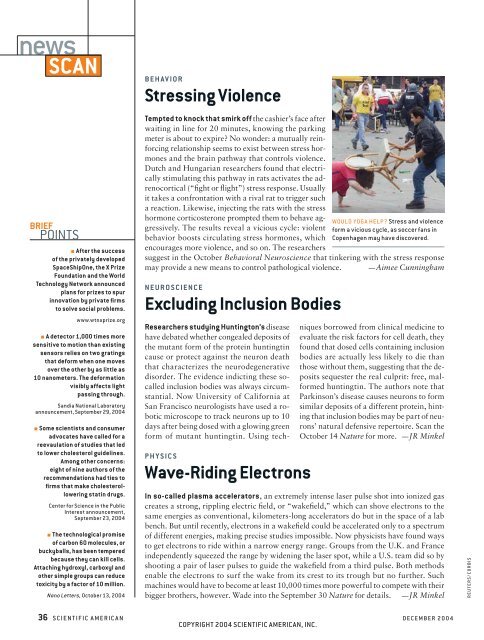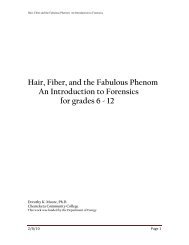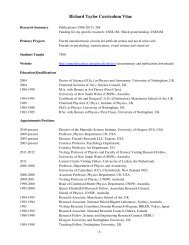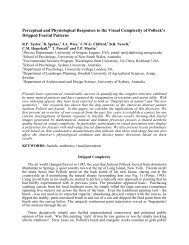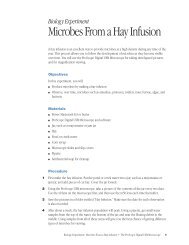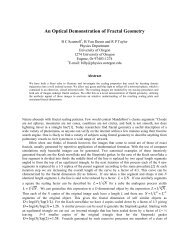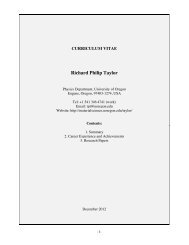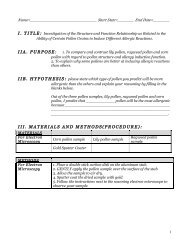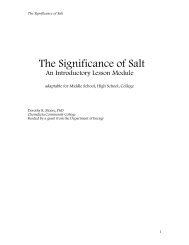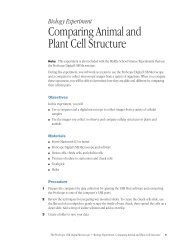December 2004 - Materials Science Institute - University of Oregon
December 2004 - Materials Science Institute - University of Oregon
December 2004 - Materials Science Institute - University of Oregon
You also want an ePaper? Increase the reach of your titles
YUMPU automatically turns print PDFs into web optimized ePapers that Google loves.
news<br />
SCAN<br />
BRIEF<br />
POINTS<br />
■ After the success<br />
<strong>of</strong> the privately developed<br />
SpaceShipOne, the X Prize<br />
Foundation and the World<br />
Technology Network announced<br />
plans for prizes to spur<br />
innovation by private fi rms<br />
to solve social problems.<br />
www.wtnxprize.org<br />
■ A detector 1,000 times more<br />
sensitive to motion than existing<br />
sensors relies on two gratings<br />
that deform when one moves<br />
over the other by as little as<br />
10 nanometers. The deformation<br />
visibly affects light<br />
passing through.<br />
Sandia National Laboratory<br />
announcement, September 29, <strong>2004</strong><br />
■ Some scientists and consumer<br />
advocates have called for a<br />
reevaulation <strong>of</strong> studies that led<br />
to lower cholesterol guidelines.<br />
Among other concerns:<br />
eight <strong>of</strong> nine authors <strong>of</strong> the<br />
recommendations had ties to<br />
fi r m s t h a t m a k e c h o l e s t e r o l -<br />
lowering statin drugs.<br />
Center for <strong>Science</strong> in the Public<br />
Interest announcement,<br />
September 23, <strong>2004</strong><br />
■ The technological promise<br />
<strong>of</strong> carbon 60 molecules, or<br />
buckyballs, has been tempered<br />
because they can kill cells.<br />
Attaching hydroxyl, carboxyl and<br />
other simple groups can reduce<br />
toxicity by a factor <strong>of</strong> 10 million.<br />
Nano Letters, October 13, <strong>2004</strong><br />
BEHAVIOR<br />
Stressing Violence<br />
Tempted to knock that smirk <strong>of</strong>f the cashier’s face after<br />
waiting in line for 20 minutes, knowing the parking<br />
meter is about to expire? No wonder: a mutually reinforcing<br />
relationship seems to exist between stress hormones<br />
and the brain pathway that controls violence.<br />
Dutch and Hungarian researchers found that electrically<br />
stimulating this pathway in rats activates the adrenocortical<br />
(“fi ght or fl ight”) stress response. Usually<br />
it takes a confrontation with a rival rat to trigger such<br />
a reaction. Likewise, injecting the rats with the stress<br />
hormone corticosterone prompted them to behave aggressively.<br />
The results reveal a vicious cycle: violent<br />
behavior boosts circulating stress hormones, which<br />
encourages more violence, and so on. The researchers<br />
suggest in the October Behavioral Neuroscience that tinkering with the stress response<br />
may provide a new means to control pathological violence. —Aimee Cunningham<br />
NEUROSCIENCE<br />
Excluding Inclusion Bodies<br />
Researchers studying Huntington’s disease<br />
have debated whether congealed deposits <strong>of</strong><br />
the mutant form <strong>of</strong> the protein huntingtin<br />
cause or protect against the neuron death<br />
that characterizes the neurodegenerative<br />
disorder. The evidence indicting these socalled<br />
inclusion bodies was always circumstantial.<br />
Now <strong>University</strong> <strong>of</strong> California at<br />
San Francisco neurologists have used a robotic<br />
microscope to track neurons up to 10<br />
days after being dosed with a glowing green<br />
form <strong>of</strong> mutant huntingtin. Using tech-<br />
PHYSICS<br />
Wave-Riding Electrons<br />
WOULD YOGA HELP? Stress and violence<br />
form a vicious cycle, as soccer fans in<br />
Copenhagen may have discovered.<br />
niques borrowed from clinical medicine to<br />
evaluate the risk factors for cell death, they<br />
found that dosed cells containing inclusion<br />
bodies are actually less likely to die than<br />
those without them, suggesting that the deposits<br />
sequester the real culprit: free, malformed<br />
huntingtin. The authors note that<br />
Parkinson’s disease causes neurons to form<br />
similar deposits <strong>of</strong> a different protein, hinting<br />
that inclusion bodies may be part <strong>of</strong> neurons’<br />
natural defensive repertoire. Scan the<br />
October 14 Nature for more. —JR Minkel<br />
In so-called plasma accelerators, an extremely intense laser pulse shot into ionized gas<br />
creates a strong, rippling electric fi eld, or “wakefi eld,” which can shove electrons to the<br />
same energies as conventional, kilometers-long accelerators do but in the space <strong>of</strong> a lab<br />
bench. But until recently, electrons in a wakefi eld could be accelerated only to a spectrum<br />
<strong>of</strong> different energies, making precise studies impossible. Now physicists have found ways<br />
to get electrons to ride within a narrow energy range. Groups from the U.K. and France<br />
independently squeezed the range by widening the laser spot, while a U.S. team did so by<br />
shooting a pair <strong>of</strong> laser pulses to guide the wakefi eld from a third pulse. Both methods<br />
enable the electrons to surf the wake from its crest to its trough but no further. Such<br />
machines would have to become at least 10,000 times more powerful to compete with their<br />
bigger brothers, however. Wade into the September 30 Nature for details. —JR Minkel<br />
36 SCIENTIFIC AMERICAN DECEMBER <strong>2004</strong><br />
COPYRIGHT <strong>2004</strong> SCIENTIFIC AMERICAN, INC.<br />
REUTERS/CORBIS


